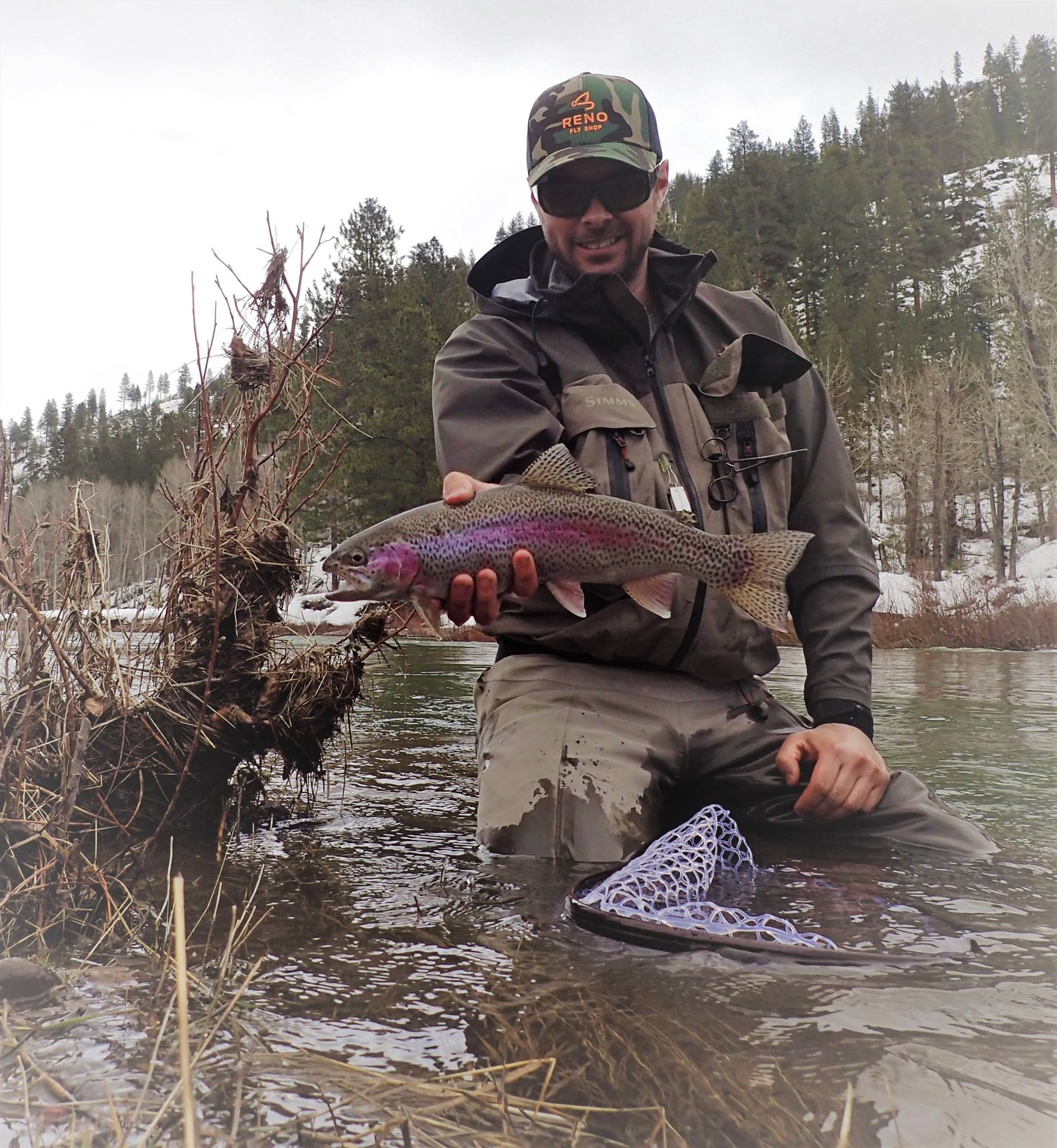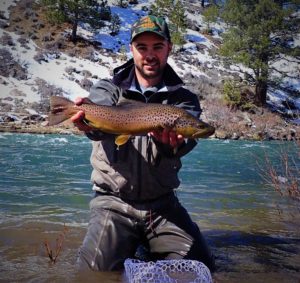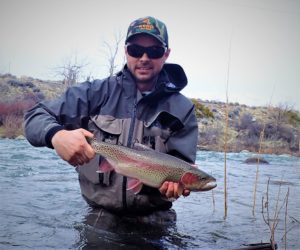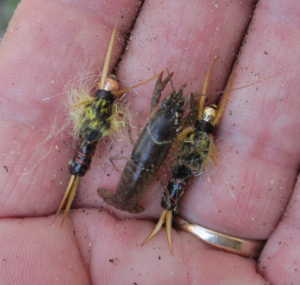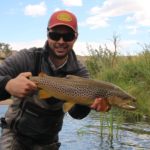Big Water, Bigger Fish
We have all heard or read the less-than-inspiring Spring time fishing report that starts “It might be a while before we see some good fishable conditions”
As folks are flipping through the different river guages looking for that ‘good’ level, I’m pulling into a dirt turn off thathas been recently plowed of historic snowfall. The Corolla sports a coat of mud, salt, and sand from Caltrans snow plows. The air is crisp, the ground soft from spring storms and runoff, and not surprisingly there isn’t another angler in sight.
One of the most popular rivers in the state whose banks host tens of thousands of hopeful anglers a year is empty. Well…. Sort of… It’s actually full. Full to the point of over flowing, a welcome change from the past 3 years of skinny water and hoot owl closures. Having begun stalking the banks of the Truckee River 2 years ago, I don’t recognize the roaring force it has become. I timidly step into my waders and get ready to take on the heavy flows. This kind of fishing isn’t for everyone, or maybe even for most, but for the dedicated angler this can be the best time of year to wrestle with the Truckee’s legendary trout.
With the departure of winter and reluctant arrival of spring comes high flows and feeding trout. Warming water and daily temperatures wake the local hatches and the fish oblige. In particular trophy trout (15-25 inches) actively feed accommodating their large appetite and metabolism. But to most torrents of muddy water make the local streams and secret spots unfishable. In reality these same obstacles can provide certain advantages to the prepared angler. Your summer sweet spots may be unreachable for now, but there are new sweet spots lining the bank. High flows will make most of the river unreachable to the angler but it also makes most of the river uninhabitable by fish.
Change your approach to the changing conditions
With the access to information now a days I normally have my rods rigged even before I wake up that morning. However this time of year I won’t rig up until I reach the bank I am starting at. This forces me to take my time, affording 10 minutes to evaluate the flows and map my approach to the area while I rig up my gear. The biggest mistake I see is anglers charging into the water trying to reach their “special” rock out in the middle of the now surging river. If they took the extra time to reevaluate their surroundings based on the increased flows they would easily be able to locate where the fish has repositioned. Big fish don’t get big by working hard. They choose the path of least resistance, and in this case it will inevitably lead them right to the bank. The other factor I pay more attention to during this time of year of low temps and high flows is gradient. I find most fish are extremely adverse to expending energy fighting current. This helps me eliminate water more than select water to fish. I’ll cruise passed the sloping runs and pools and focus on the flat areas. This can be hard to do if you don’t step back and take a larger scale view of the river. Again this highlights the fresh outlook you must have. The high winter/spring flows in effect concentrate the fish into small windows. The windows maybe dingy and hard to see through, but to a trophy trout has a shorter time to decipher an imposter from an natural meal. With a precise presentation you can fool some trophy trout.
Modern Nymphing
I leave the thingamabobbers at home and employ an indicator-less technique. This technique has more names than Bigfoot, such as tight lining, naked nymphing, czech nymphing, and euro nymphing. The major differences between your standard nymph rig and a euro rig are a heavy anchor fly that replaces the need for split shot. Colored mono (sighter) and most importantly the Feel that replaces the indicator telegraphing the take. Modern Nymphing uses a long rod with short casts and a tight line to fish precise locations. Without an indicator and split shot to drag the flies through seams, the flies have time to find the strike zone and look more natural to wary trout. Everyone seems to have their own percentage of how many strikes you miss with an indicator. For me the jist is I will always see and feel more strikes tightlining than I ever could with an indicator. I’ve found large fish especially in the winter are the lightest takes. If I get a solid grab I assume it’s a 16 inch rainbow. The large trout I’m after often leave no sign, but a gut feeling to set the hook. With an indicator I wouldn’t even have noticed. I also find this technique narrows my focus of the water I am fishing. Drawing more attention to each individual seam applying a sniper like approach to the river.
What once was one just a “seam” is now a 4 part inside, outside, front, and tail seam.
Ammunition
My flies of choice will invariably be a worm anchored by a heavily weighted fly representing either a sculpin or a crawfish. Frankly this is the only time of year I make sure no one is looking and tie on a worm; it’s just too effective!!!! This pattern is more effective now with the past 3 years of draught thirsty banks finding themselves submerged for the first time in a long time. If the Truckee River was able to choose, 2017 would definitely be the Year of the Worm. Anchor flies require a lot of weight especially in high flows. Most flies from your local fly bin will not have the weight to get your flies down into the fish’s face, and every second you’re not on the bottom is a second your fishing and not catching. This time of year large trout ditch their new year’s resolution of eating right and will skip the midge and go right to the seemingly calorie rich Anchor fly. I generally start with a sculpin imitation in the colder water since the crawdad activity is limited. As the water warms I’ll transition over to a crawdad pattern. In my experience sculpin patterns seem to be more effective on the CA side and Crawdads more prevalent on the NV side. In my opinion there is no better crawdad pattern out there than the Stonedaddy tied by local guide Doug Oullette. The Reno Fly Shop always has a surplus on hand with how deadly this fly is. The 2 things I look for in my anchor pattern is weight and a hook that rides hook point up. In this high water there will more submerged brush and snags to slow you down. The jig hook will lower the amount of snags and prevent your hook point from becoming dull from banging into the rocks.
The Walk-Up and the Stick-and-Move
I approach the swelling river with caution. From a higher vantage point I map my approach seam by seam, never neglecting the bank. You read all the time about the fish right under your feet and this is no truer than in the spring when lazy river bottom bullies hide from the unrelenting current. Starting on my knees I hit my mark inches from the bank, I lead the tandem of flies through the nearest seam feeling the anchor fly polishing the streambed. If no one’s home so I continue the search. I pitch my rig into a slow deep seam paralleling the bank. I lower the sighter into the water to achieve greater depth to ensure I’m on the bottom. Suddenly the limp line tighten with good news. My 10ft 4 weight, Sage ESN, bends with the mass of a large fish amplified by the sheer volume of the current no more than 4 feet from my boots. In this water a fish doesn’t need to fight much to make an angler’s life difficult, and with strikes at a premium this time of year every hookset counts. The one advantage this milky water affords me is the ability to wield 3x RIO Fluoro Flex. With confidence and panic I negotiate the brute towards the shore. I wrench hard on the rod running the risk of pulling the hook, but if the fish gets into the main current he’s as good as gone anyway. The side-to-side headshaking gets me dreaming of a trophy that even my dad might admit he’s jealous of. A yellow hew detaches from the river bottom and then a flash of white of from its shaking mouth weakens my knees. This is why I bought a bigger net I tell myself as I fumble for my holster. Finally a tail breaks the surface and reveals a fish more likely measured in pounds than inches. I extend the net praying if God only lets me catch this one fish I promise to sit up front this Sunday. I make one more desperate plunge with the net and coral the reward of 2 hours of driving on icy roads. I let out a relieved icy sigh, “This is why I’m here”, and it’s why you should be too. If you’re looking for no crowds, challenging fishing, and big rewards don’t heed the reports and hit the Big Water of the Truckee River.


